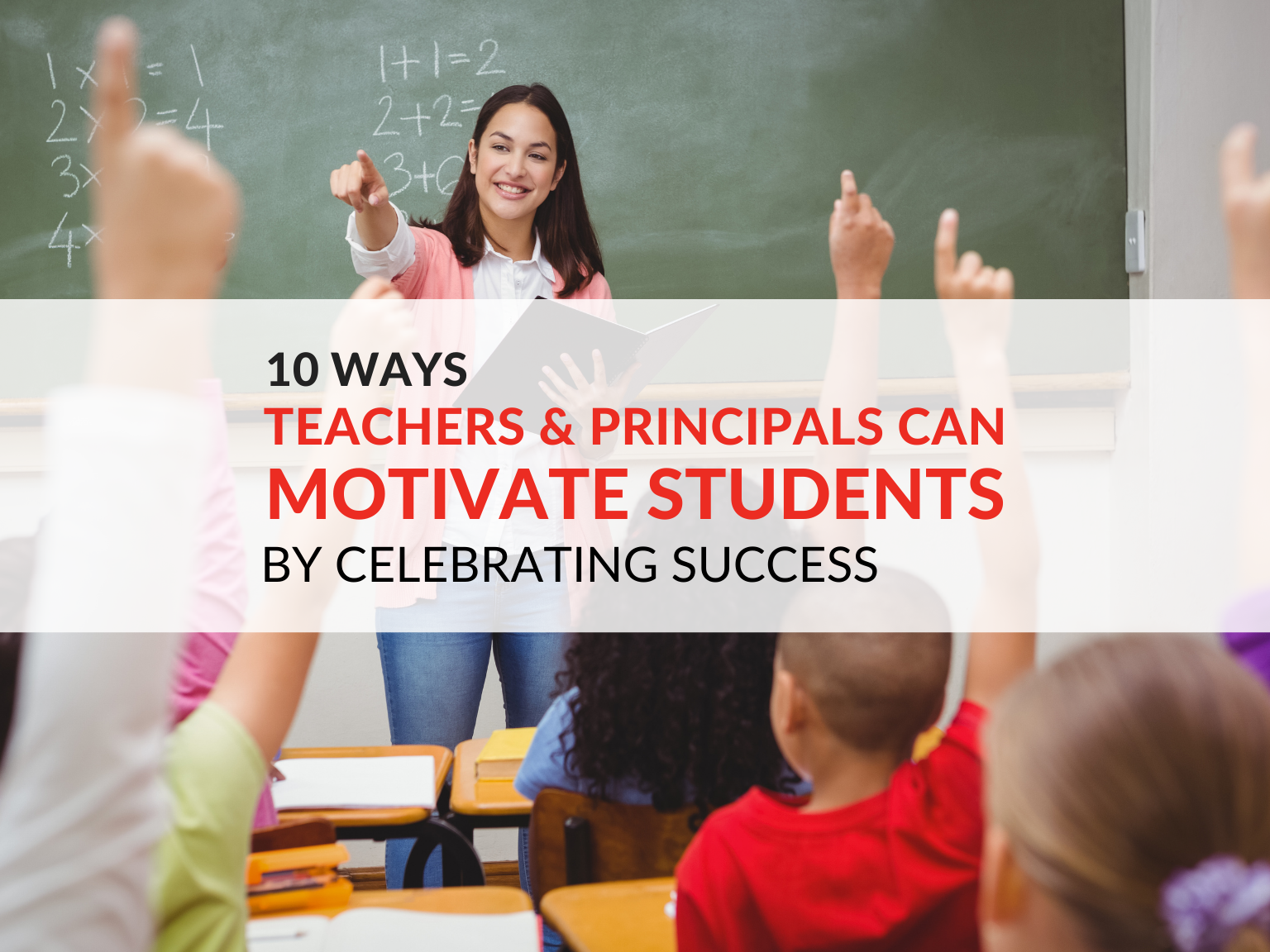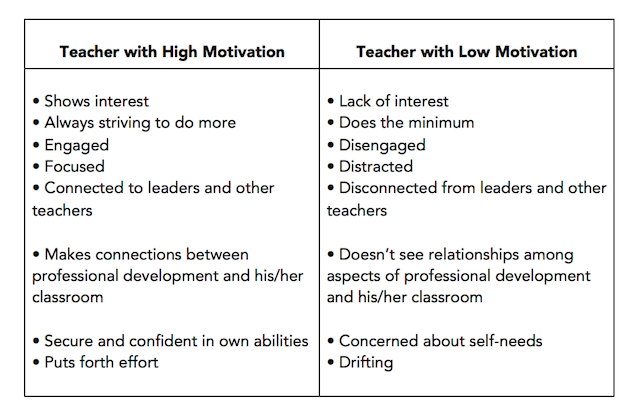Teachers motivate students by understanding their individual needs and creating a supportive and engaging learning environment. Effective motivation plays a crucial role in a student’s academic success.
When teachers understand the unique needs and interests of their students, they can create an environment that fosters motivation and engagement. Motivated students are more likely to be actively involved in the learning process, leading to improved learning outcomes. This article explores various strategies teachers can use to motivate their students, including providing meaningful and relevant learning experiences, establishing clear expectations, offering praise and recognition, and fostering a positive classroom culture.
By implementing these strategies, teachers can empower their students to take ownership of their learning and reach their full potential.

Credit: www.sadlier.com
Understanding Student Motivation
When it comes to teaching, one of the key challenges for educators is how to motivate students. Understanding student motivation is crucial for creating an engaging and effective learning environment. When students are motivated, they are more likely to be actively involved in their education, take ownership of their learning, and achieve better results. This article explores the factors that influence student motivation and highlights the importance of cultivating motivation in the classroom.
Factors Affecting Student Motivation
To understand student motivation, it is essential to consider the various factors that influence it. These factors can vary from student to student, but some common ones include:
- 1. Self-efficacy: The belief in one’s ability to successfully complete a task plays a significant role in motivating students. When students have confidence in themselves and their abilities, they are more likely to stay engaged and persist in their efforts.
- 2. Relevance: Students are more motivated when they perceive the content and activities as meaningful and applicable to their lives. As educators, it is essential to establish connections between the curriculum and real-world scenarios to enhance motivation.
- 3. Goals and expectations: Setting clear, achievable goals and providing students with a sense of purpose can greatly influence their motivation. Students who are aware of what they are working toward and understand the expectations have a stronger sense of direction and drive.
- 4. Classroom climate: The overall classroom environment, including the relationship between the teacher and students, can impact motivation. Providing a positive and supportive atmosphere where students feel comfortable taking risks and expressing themselves fosters motivation.
- 5. Intrinsic and extrinsic rewards: Both intrinsic (internal) and extrinsic (external) rewards can motivate students. Intrinsic rewards, such as a sense of accomplishment or personal growth, can be powerful motivators. Extrinsic rewards, such as praise or recognition, can also play a role in motivating students.
The Importance Of Student Motivation
Student motivation is vital for several reasons. First and foremost, motivated students are more likely to be active participants in their learning process. They exhibit higher levels of engagement and are willing to invest effort to achieve their goals. Moreover, motivated students are more likely to persist in the face of challenges and setbacks, as they understand the value of their education.
Furthermore, student motivation is closely linked to academic achievement. When students are motivated, they tend to perform better academically, leading to improved grades and overall learning outcomes. Motivated students are also more likely to develop essential skills such as critical thinking, problem-solving, and self-regulation, which are crucial for their future success.
As teachers, it is our responsibility to foster and nurture student motivation. By understanding the factors that influence motivation and creating a conducive classroom environment, we can inspire and empower our students to reach their full potential.

Credit: catchbox.com
Creating A Positive Learning Environment
Creating a positive learning environment is crucial for teachers to effectively motivate students. When students are in an environment that promotes positivity, they feel safe, valued, and engaged in their learning. Such an environment encourages students to take risks, collaborate with their peers, and actively participate in classroom activities.
Establishing Clear Expectations
One way teachers can create a positive learning environment is by establishing clear expectations. When students know what is expected of them academically and behaviorally, they feel more confident and motivated to meet those expectations. Teachers can communicate clear guidelines, rules, and objectives at the beginning of each lesson, ensuring students know what they need to achieve. Providing a structured framework helps students focus and promotes a sense of security within the classroom.
Encouraging Peer Support And Collaboration
Another effective strategy for creating a positive learning environment is encouraging peer support and collaboration. When students work together, they develop important social skills, such as communication, problem-solving, and empathy. This collaborative environment allows students to feel connected to their peers, fostering a sense of belonging and motivation. Teachers can design activities that promote teamwork, such as group projects or discussions, allowing students to learn from each other and build a supportive community within the classroom.
Providing Constructive Feedback And Praise
Teachers can further foster a positive learning environment by providing constructive feedback and praise to their students. Constructive feedback helps students identify areas for improvement and understand how to enhance their learning. It is important for teachers to provide feedback in a constructive and specific manner, highlighting both strengths and areas that need improvement. Additionally, praising students for their efforts and achievements boosts their self-confidence, motivation, and overall engagement. By offering feedback and praise, teachers create a supportive atmosphere where students feel valued and encouraged to continue their learning journey.
Using Varied Teaching Strategies
Motivating students is a crucial aspect of effective teaching. While each student has unique needs and interests, one tried-and-true method to inspire motivation is through the use of varied teaching strategies. By employing different approaches, educators can create an engaging classroom environment that caters to the diverse learning styles and interests of their students.
Differentiating Instruction To Meet Student Needs
One of the key strategies in motivating students is differentiating instruction. This involves tailoring lesson plans, activities, and assessments to match the individual abilities, interests, and learning preferences of each student. By understanding that every student learns in a unique way, teachers can adapt their teaching strategies to ensure all students feel valued and included in the learning process.
Teachers can differentiate instruction by:
- Providing flexible grouping options, such as working in pairs, small groups, or individually, based on students’ strengths and weaknesses.
- Offering a variety of materials and resources to accommodate diverse learning styles, including visual aids, hands-on manipulatives, and audio recordings.
- Adjusting the pace of instruction to cater to the varying levels of comprehension among students.
Incorporating Hands-on Activities And Real-world Examples
Another powerful way to motivate students is by incorporating hands-on activities and real-world examples in the classroom. These approaches not only make learning fun but also help students see the relevance and practical application of their studies in real life.
To foster engagement and motivation, teachers can:
- Organize experiments, simulations, or role-plays that enable students to actively participate in the learning process.
- Integrate real-world scenarios and case studies to demonstrate the practicality of the concepts being taught.
- Encourage students to explore their own interests and passions by incorporating project-based learning, allowing them to apply their knowledge to solve real problems.
Using Technology To Enhance Engagement
In this digital age, technology plays a pivotal role in enhancing student engagement and motivation. By incorporating various technological tools and resources into the classroom, teachers can tap into students’ digital literacy and cater to their tech-savvy learning preferences.
To leverage technology for enhanced engagement, teachers can:
- Integrate multimedia elements such as videos, interactive animations, and online simulations to illustrate complex concepts visually.
- Utilize online platforms and educational apps to provide personalized and interactive learning experiences.
- Encourage collaboration and communication through virtual group projects and online discussions.
By employing these varied teaching strategies, educators can create an environment that fosters motivation, engagement, and academic growth for all students. Remember, every student is unique, and by recognizing and catering to their individual needs and interests, we can inspire and unlock their full potential.

Credit: www.middleweb.com
Promoting Autonomy And Choice
Teachers motivate students by promoting autonomy and choice, empowering them to take ownership of their learning journey. Encouraging self-determination helps students develop intrinsic motivation, leading to greater engagement and academic success. With increased autonomy, students feel a sense of control over their education, fostering a positive and empowering learning environment.
Allowing Students To Make Decisions In Their Learning
One effective way teachers motivate students is by promoting autonomy and choice in the classroom. By allowing students to make decisions in their learning, teachers can foster a sense of ownership and engagement. This approach not only empowers students to take charge of their education but also enhances their motivation and desire to learn.
When students have the freedom to make decisions, they feel more invested in their education. This can be achieved by giving students options on how they want to complete assignments, encouraging them to choose topics that interest them, or granting them the opportunity to set personal goals.
By embracing this approach, teachers create a learning environment that caters to individual student needs and preferences. Students are more likely to excel when they have a say in their education, as they feel valued and respected. Moreover, this approach also enhances their critical thinking skills and problem-solving abilities as they weigh different options and make informed choices.
Providing Opportunities For Student Voice And Choice
Another effective way teachers motivate students is by providing opportunities for student voice and choice in the classroom. When students are given the chance to express their opinions and actively participate in decision-making processes, their motivation and engagement levels soar.
Teachers can encourage student voice by incorporating activities and discussions that allow students to share their thoughts, ideas, and concerns. Creating an inclusive and safe environment where students feel comfortable expressing themselves is crucial. By valuing their input, teachers not only empower students but also shape an environment that fosters independence and critical thinking.
Student choice can be facilitated through various means, such as offering multiple project options, allowing students to select their reading materials, or even encouraging them to choose their preferred learning methods. When students have a sense of agency and control over their learning, they become more motivated to succeed.
Encouraging Independent Thinking And Problem-solving
Teachers can further motivate students by encouraging independent thinking and problem-solving skills. By promoting these skills, teachers empower students to become active participants in their learning process, preparing them for real-life challenges both inside and outside the classroom.
When students learn to think independently, they become more self-reliant and confident in their abilities. Teachers can foster independent thinking by encouraging students to question, analyze, and evaluate information critically. By promoting open-ended discussions, teachers allow students to explore different perspectives and develop higher-order thinking skills.
Problem-solving skills are invaluable in students’ lives. Teachers can incorporate activities that require students to think creatively and find solutions to real-world problems. By presenting challenging tasks and giving students the freedom to explore different approaches and strategies, teachers can ignite curiosity and a love for learning.
Nurturing Intrinsic Motivation
Intrinsic motivation plays a crucial role in a student’s academic success. When students are intrinsically motivated, they are driven by their own internal desires and beliefs, rather than external rewards or pressures. Nurturing this type of motivation requires teachers to create an environment that fosters a sense of purpose and relevance, provides opportunities for mastery and growth, and cultivates curiosity and a love of learning.
Fostering A Sense Of Purpose And Relevance
A sense of purpose and relevance is essential for students to feel motivated in their studies. Teachers can foster this by connecting classroom content to real-life applications and showing students how their learning directly relates to their own lives. By making lessons meaningful and demonstrating the value of knowledge, teachers can ignite a sense of purpose in students.
Providing Opportunities For Mastery And Growth
Students thrive when they have opportunities to master new skills and witness their growth. To nurture intrinsic motivation, teachers should create a supportive environment that encourages students to take risks, make mistakes, and learn from them. By providing constructive feedback and celebrating progress, teachers help students develop a growth mindset and a desire for continuous learning.
Cultivating Curiosity And A Love Of Learning
A curious mind is a motivated mind. Teachers can cultivate curiosity and a love of learning by creating an environment that sparks students’ curiosity and encourages them to ask questions. By incorporating hands-on activities, interactive discussions, and real-world examples, teachers can inspire a sense of wonder and ignite students’ curiosity. Additionally, celebrating students’ interests and passions can further fuel their intrinsic motivation to explore and learn.
Building Positive Relationships With Students
One of the key factors in motivating students is the establishment of positive relationships between teachers and students. Building trust, understanding, and respect leads to a nurturing environment where students feel supported and motivated to succeed. Below, we will explore three crucial aspects of building positive relationships with students.
Getting To Know Students Individually
Every student is unique, with their own strengths, weaknesses, and personalities. As a teacher, taking the time to get to know each student individually can have a profound impact on their motivation. By understanding their interests, ambitions, and challenges, teachers can tailor their approach to better engage with each student. This can be done through:
- Regular conversations to learn about their hobbies, dreams, and aspirations.
- Student surveys or questionnaires to gain insights into their preferred learning styles.
- Observing their interactions with peers and their behavior in the classroom.
Showing Empathy And Understanding
Empathy and understanding are essential qualities for teachers aiming to motivate their students. By showing genuine empathy, teachers can create a safe and supportive environment where students feel understood and valued. Some ways teachers can display empathy include:
- Listening attentively to students’ concerns and addressing them appropriately.
- Considering a student’s personal circumstances and accommodating them whenever possible.
- Recognizing and acknowledging the challenges students may face outside the classroom.
Building Trust And Mutual Respect
A sense of trust and mutual respect lays a solid foundation for positive teacher-student relationships. When students trust their teacher, they are more likely to actively participate and engage in the learning process, leading to increased motivation. To build trust and mutual respect, teachers can:
- Follow through on promises and commitments made to students.
- Provide constructive feedback and praise to students for their efforts and achievements.
- Encourage open communication and active participation in the classroom.
By focusing on building positive relationships with students through these practices, teachers can create an environment that fosters motivation, engagement, and ultimately, success. When students feel connected to their teacher, they are more likely to take ownership of their learning and strive for excellence.
Frequently Asked Questions Of How Do Teachers Motivate Students?
In What Way Do Teachers Motivate Students?
Teachers motivate students by creating an engaging learning environment, offering praise and rewards, setting clear goals, providing constructive feedback, and using interactive teaching methods.
How Do You Motivate Your Student?
To motivate students, provide clear goals, offer rewards for achievements, give personal attention, encourage active participation, and make learning relevant to their lives.
What Is The Role Of Teachers In Motivating Students?
Teachers play a vital role in motivating students by creating a positive and engaging learning environment. They can inspire curiosity, provide encouragement, and offer guidance to help students set and achieve their goals. By understanding students’ needs and interests, teachers can tailor instruction to foster a love for learning.
How Can Teachers Develop Students Motivation — And Success?
Teachers can develop students’ motivation and success by creating an engaging and supportive learning environment. They can use various strategies like setting clear goals, providing feedback, offering rewards, and employing interactive teaching methods. The key is to connect with students, understand their needs, and empower them to take ownership of their learning.
Conclusion
To sum up, effective teachers understand the power of motivation in their classrooms. By creating a positive and supportive learning environment, providing meaningful and relevant content, and utilizing various teaching strategies, they can inspire and engage students. By acknowledging and celebrating students’ achievements, setting realistic goals, and fostering a growth mindset, teachers can fuel their students’ desire to succeed.
Ultimately, when teachers motivate their students, they pave the way for lifelong learning and future success.